03 - What Do You Know About Our Mennonite Roots?
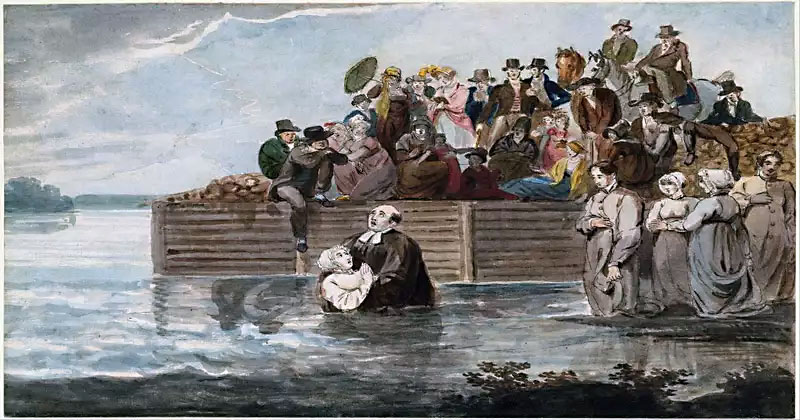
Rev. Samuel Hiestand's parents, grandparents, and several generations before were all Mennonites.
"Samuel Hiestand" - Wikipedia
This Samuel Hiestand was our Daniel Haston’s nephew, son of Daniel’s oldest brother Jacob.
Huldrych (Ulrich) Zwingli

You know about Martin Luther and the Protestant Reformation in Germany, but you may not know about Ulrich Zwingli, the Protestant Reformer in Switzerland, a contemporary with Luther.
Like Luther, Zwingli was a Catholic priest who began to study the New Testament in its original language of Greek and wanted to return the Church to the way it was in New Testament times.
Each of these reformers espoused some of his own unique teachings, but there were some major reformation doctrines on which they all agreed:
- Sola Scripture (by Scripture alone) – The final authority for Christian faith and life is the Bible, not the non-biblical teachings of the Church.
- Sola Fide (by faith alone) and Sola Gratia (by grace alone) – We are justified before God by “grace through faith and that not of ourselves, it is a gift of God.” (Ephesians 2:8)
- Priesthood of all true believers – Jesus is the only true mediator or priest between us and God the Father.
Zwingli's Students Disappointed with Him
But some of Zwingli’s students, Conrad Grebel, Felix Manz, and others thought that Zwingli wasn’t going far enough–especially since he still insisted that infants must be baptized for their salvation. And, Zwingli still believed that the State (ruling government) should control churches and force them to attend the official State Church. Grebel, Manz, and others in this group of young bright Greek and Hebrew scholars also opposed such things as the Catholic doctrine of mass, the sale of indulgences, celibacy of priests, the doctrine of purgatory, and images in the church building which Zwingli wasn’t willing to give up because of political pressures from the City Council of Zurich.
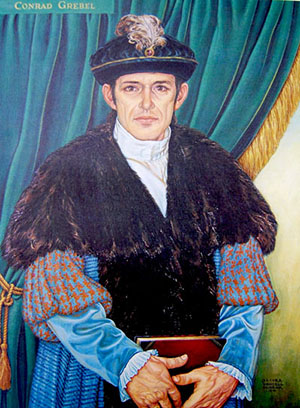
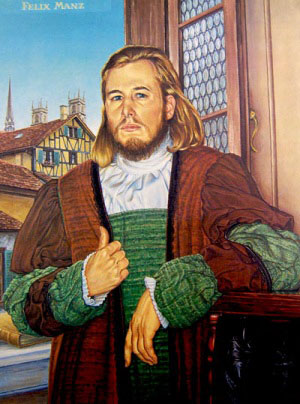
By January 1525, a former Catholic priest Jörg Cajakob (who became known as George Blaurock) had joined Grebel and Manz in Zürich. Blaurock came from his home canton in southeastern Switzerland, and took up their cause with great, and even sometimes reckless, zeal.

These gifted young intellectuals were attracted to Zwingli and his study of the Greek New Testament, Greek being the original language in which the New Testament was written.
By 1522 these young men had become zealous for reforming the Catholic Church, just as much as Zwingli was, but they desired to be more fully consistent with the teachings of the New Testament.
In October of 1523, in the second of two disputations in Zürich between leaders of the reformed movement and the Roman church, Zwingli chose to leave it up to the city magistrates of Zürich to decide when to discontinue the Roman practice of mass, in favor of a simple memorial of death of Jesus. Grebel, Manz, and others from Zwingli’s group of New Testament students were greatly disappointed—even outraged—that Zwingli appealed to the authority of the Council rather than obeying the authority of Scripture.
Zwingli’s attempts to calm his former disciples failed and a disputation was scheduled for Zürich in January 1525 to try to settle the differences between Zwingli and Grebel, Manz, and their friends. The Council proclaimed Zwingli to be the winner of the dispute and gave the young radicals three options: 1. conform, 2. leave Zürich, or 3. face imprisonment.
Then on the night of January 21, 1525 these young radicals took a very radical step in extending the reformation to its next level of consistency with the New Testament. In a prayer meeting involving 15 men in the home of Felix Manz’s mother in the city of Zürich, George Blaurock
…stood up and besought Conrad Grebel for God’s sake to baptize him with the true Christian baptism upon his faith and knowledge. And when he knelt down with such a request and desire, Conrad baptized him, since at that time there was no ordained minister to perform such a work.
After his baptism at the hands of Grebel, Blaurock proceeded to baptize all the others present. The newly baptized then pledged themselves as true disciples of Christ to live lives separated from the world and to teach the gospel and hold the faith.[i]
From this time forward, adult baptism based upon a confession of faith in Jesus Christ became the central tenet of faith for the people known as Anabaptists (re-baptizers). When these Anabaptists began to baptize other adult believers in the villages of Zürich and refuse to have their own children baptized as infants, Zwingli and the Zürich Council responded with harsh persecution. To the Catholic Church and the Zwinglians, failure to baptize an infant was a serious offense because the salvation of the infant’s soul depended on it, in their thinking. Also, refusal to do so was civil disobedience—rebellion against the State.
[i] William R. Estep, The Anabaptist Story (Grand Rapids: Eerdmans, 1975), 14.
The names “Swiss Brethren,” “Anabaptists,” and “Mennonites” are all used interchangeably in many articles and books dealing with the history of this group of religious non-conformists. But, technically speaking while the three names all refer to the same religious sect, each name had a distinct origin. Generally, today we refer to them as Mennonites.
Anabaptists in Richterswil and Wädenswil
Apparently, Richterswil and Wädenswil became a hotbed of Anabaptism sometime early in the movement. Ten years after Blaurock baptized Grebel and the movement was launched, “a Zürich report in 1535 observed that Anabaptists were increasing in numbers and preaching at ‘Wädenswil and all along the lake.'”[i] The area south of Lake Zürich became known as “The Mennonite Cradle in Zürich.”
[i] Harold S. Bender, “Zürich (Switzerland).”
We do know that the Hiestand clan was one of the largest and more prominent families in Richterswil[i] and probably also in Wädenswil, but we do not know for sure how much they were affected in the 1500s by the Anabaptist contagion. But, during the 1600s Hiestands definitely became an integral part of the Anabaptist movement.
[i] J. Ross Baughman, Apart from the World, 45.
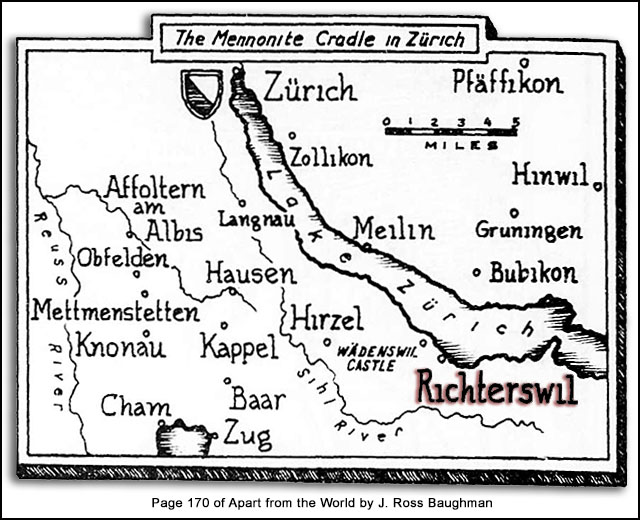
300 Years of Persecution Begins
Unfortunately for the early Swiss Brethren, Conrad Grebel, often called the “Father of the Anabaptists,” died of the plague at the age of 28, within 20 months following the origin of the movement. Felix Manz became the first martyr for the Anabaptist cause. Because he was a citizen of Zürich, Manz was executed by drowning on January 5, 1527 in icy waters of the Limmat River in the city of Zürich. To the Swiss authorities, execution by drowning was the “third baptism”—a mockery of Anabaptists’ re-baptisms.
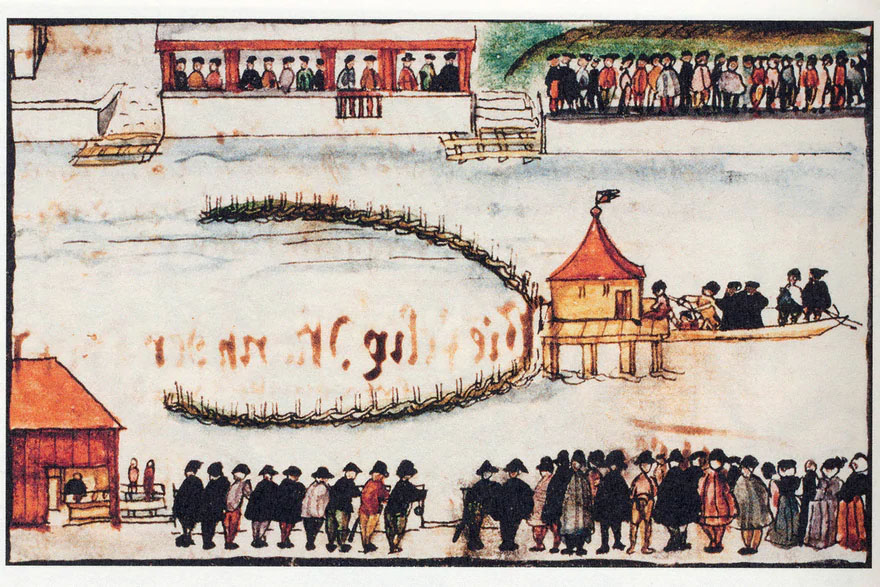
The people of Zurich crowded along both sides of the Limmat to follow the macabre scene playing out in the middle of the river. Felix Manz, his hands and feet bound, crouched down on the deck of the fisherman’s cottage and sang a full-throated rendition of the psalm “Into thine hand I commit my spirit.”
Regula Bochsler,
On the same day Manz was martyred, Blaurock who was not a Zürich citizen, was mercilessly beaten in Zürich and expelled from that city and canton. On September 6, 1529, Blaurock was burned at the stake in what is now northern Italy. Many other Anabaptists suffered horrendous physical torture, suffered long or died in prisons, were executed, or were forced to abandon their property and be exiled from their Swiss homeland. That was just the beginning—the beginning of nearly 300 years of persecutions for Anabaptists in Switzerland.
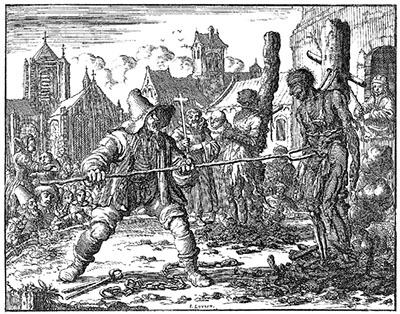
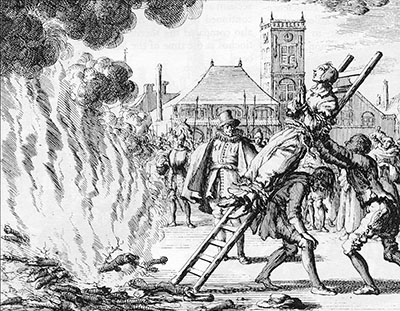
The deaths and exiles of its early leaders certainly subdued the Anabaptist movement, especially in the city of Zürich, but the flame was not extinguished. The fires of Anabaptism spread from Zürich to other cantons of Switzerland, such as Bern, as well as other parts of Europe. And although the fire smoldered in the city of Zürich, it began to ignite in many of the villages within Canton Zürich, especially on the northeast of Lake Zürich around Grebel’s boyhood home, Grüningen, where he evangelized house-to-house for four months while avoiding the city of Zürich.[i] “By 1727 there were thirty-eight congregations in the canton of Zürich alone.”[ii]
[i] William R. Estep, The Anabaptist Story, 39.
[ii] C. Henry Smith, The Mennonite Immigration to Pennsylvania. (Norristown, PA: Norristown Press, 1929), 14.
In the next article, we will see that eventually (almost) all Anabaptists were forced to flee Switzerland. Some (but not all) Hiestand families were among the refugees who left all to follow Jesus according to their Christian convictions.
The Anabaptists
If you enjoyed this article, please share it with others who might be interested.

